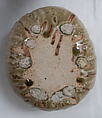Bowl
Isamu Noguchi 野口勇 American
Not on view
Isamu Noguchi created ceramics only during three short sojourns in Japan, in 1931, 1950, and 1952. These were intense periods during which he explored his roots and interacted with a wide range of artists, including traditionalists such as Kitaōji Rosanjin (1883–1959) and potters designated as Living National Treasures; avantgarde artists such as Okamoto Tarō (1911–1996); and members of the avantgarde Sōdeisha group. The ceramics Noguchi produced in the studio of Rosanjin in 1950 and 1952 ranged from large sculptural works to tableware. Rosanjin’s works, technique and the materials he used deeply influenced Noguchi’s style as well classic Japanese tableware and tea utensils. Noguchi made this bowl in 1952, in Rosanjin’s workshop, applying his glaze. The large, ovoid bowl is handbuilt, and covered with the thick green glaze which pooled in the grooves of the surface. The shape of the bowl could have been inspired by tea bowls, and inside of the bowl the accumulated glaze of bluish-green hue recalls the color of tea. The vessel is signed by the artist on the bottom and authenticated in a letter dated January 20, 1984. Dipping into the rich traditions of pottery in Japan, Noguchi could confront his ambiguous cultural identity as a Japanese American.
Due to rights restrictions, this image cannot be enlarged, viewed at full screen, or downloaded.
This artwork is meant to be viewed from right to left. Scroll left to view more.




